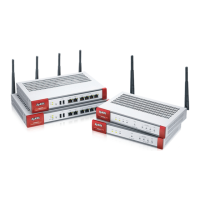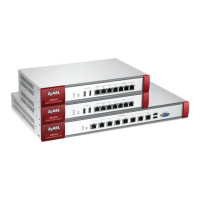Chapter 10 Routing
ZyWALL ATP Series User’s Guide
316
1 Enable OSPF.
2 Set up the OSPF areas.
3 Configure the appropriate interfaces. See Section 9.3.1 on page 213.
4 Set up virtual links, as needed.
10.7.1 Configuring the OSPF Screen
Use the first OSPF screen to specify the OSPF router the Zyxel Device uses in the OSPF AS and maintain
the policies for redistribution. In addition, it provides a summary of OSPF areas, allows you to remove
them, and opens the OSPF Add/Edit screen to add or edit them.
Click Configuration > Network > Routing > OSPF to open the following screen.
Figure 215 Configuration > Network > Routing > OSPF
The following table describes the labels in this screen. See Section 10.7.2 on page 317 for more
information as well.
Table 128 Configuration > Network > Routing Protocol > OSPF
LABEL DESCRIPTION
OSPF Router ID Select the 32-bit ID the Zyxel Device uses in the OSPF AS.
Default - the first available interface IP address is the Zyxel Device’s ID.
User Defined - enter the ID (in IP address format) in the field that appears when you select
User Define.
Redistribute
Active RIP Select this to advertise routes that were learned from RIP. The Zyxel Device advertises
routes learned from RIP to Normal and NSSA areas but not to Stub areas.
Type Select how OSPF calculates the cost associated with routing information from RIP.
Choices are: Type 1 and Type 2.
Type 1 - cost = OSPF AS cost + external cost (Metric)
Type 2 - cost = external cost (Metric); the OSPF AS cost is ignored.

